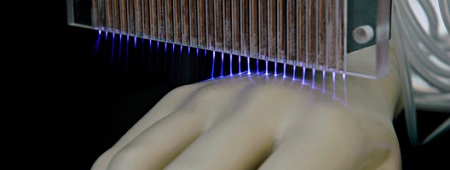A research team out of Massachusetts General Hospital has reported the repeated use of pulsed electric fields on injured areas of the body can help reduce the development of scarring.
The noninvasive procedure, referred to as “partial irreversible electroporation”, does not generate heat when in use. Tests have proven successful thus far in an animal model, and have improved several skin properties by removing excess skin cells.

“We showed that killing some, but not all of the cells in the wound could actually help regenerate skin without scarring,” says lead author Alexander Golberg, PhD, of the MGH-CEM . “The main difference between this approach and procedures like ultrasound and lasers is that they operate on the whole tissue, while pulsed electric field treatment works on only a cellular level, which we expect will provide more precise treatment results in the future as we are able to target cells specifically.”
For those unaware, scarring results from alterations in the responses of all the many different tissues involved in wound healing. Despite recent advances made in regards to understanding this process, the precise molecular mechanisms of scar formation aren’t fully understood. This has resulted in a bevy of therapeutic procedures coming out in recent years, including surgical removal, laser therapy, and steroid injections. None have proven to be a complete success yet.
Pulsed Electric Fields works by inducing the formation of tiny pores in cellular membranes. This actually kills the cells, thereby ensuring there’s no damage to the extracellular matrix or nearby blood vessels or other structures. It also causes nearby cells to proliferate and release factors promoting tissue growth and repair.
In this particular study by Massachusetts General Hospital, the research team was able to determine an optimal strength, number of pulses, and number of treatments required to reduce the formation of scars in rats that experienced burn injuries. Specifically, five treatment sessions, spaced 20 days apart after burn injury reduced the size of the scars by nearly 60%. It also improved a number of properties of the scars, including overall appearance, as well as the structure, density, and direction of the scar’s collagen fibers.
“The progress of therapies to treat scars has been very slow, with very few new technologies in the area, mostly because of the complexity of the problem and the lack of suitable animal models,” says Martin Yarmush, MD, PhD, director of the MGH-CEM and senior author of the report. “We now need to investigate whether this new technology and approach will show results in human patients, and we are looking for funding to help us design, build and test a device for clinical application.”
To learn more, read the full study, entitled “Preventing Scars after Injury with Partial Irreversible Electroporation”, which was published in the Journal of Investigative Dermatology .
Advertisement
Learn more about Electronic Products Magazine





